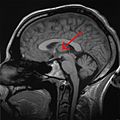AY Honors/Brain and Behavior/Answer Key
Brain and Behavior
Be able to label a diagram or a model of a human brain including the following parts and tell briefly what each part does:
- Medulla oblongata.jpg
Medula
- Midbrain.jpg
Midbrain
- Grays pituitary.jpg
Pituitary Gland
- Cerebrum.jpg
Cerebrum
Medulla
The medulla controls the autonomic functions such as breathing, and heartbeat. These are things a person does not need to think about but which happen without concious effort.
Pons
The pons is a knob on the brain stem. It is part of the autonomic nervous system, and relays sensory information between the cerebellum and cerebrum.
Cerebellum
The cerebellum plays an important role in the integration of sensory perception and motor output.
Midbrain
Thalamus
The thalamus can be thought of as a relay station for nerve impulses carrying sensory information into the brain. It receives these sensory inputs as well as inputs from other parts of the brain and determines which of these signals to forward to the cerebral cortex.
Hypothalamus
The hypothalamus links the nervous system to the endocrine system by stimulating the secretion of hormones from the pituitary gland.
Pituitary gland
The pituitary gland secretes hormones regulating a wide variety of bodily activities, including hormones that stimulate other endocrine glands.
Cerebrum
The cerebrum is wherethinking occurs. This is the area of the brain responsible for language, memory, and emotion, as well as motor control and the sense of smell.
What is a neuron? Draw a picture of a typical neuron and label its parts. Where does information enter a neuron and where does information leave from?
Explain how drugs affect the function of neurons especially at the 'synapse'. Make a commitment never to take drugs except for medical reasons.
What is a reflex? Perform a knee-jerk reflex test on someone. Explain why it occurs (use the following terms in your answer: sensory neuron, motor neuron, spinal cord). Why do doctors use this test in a physical exam?
Instructions: Gently tap someone just below the knee-cap while the person's leg is hanging over the edge of a chair.
What is a sensory neuron, and what is "adaption". Demonstrate adaption by doing the following:
Rest your arm on a table and then place a small cork (or something very light) on your arm. Notice how it feels at that time and how it feels one minute later after not moving.
Place one finger of one hand in a bowl of cool water and another finger of the other hand into a bowl of warm water. After 30 seconds, put both fingers in to a bowl of water at room temperature. How does the water at room temperature feel on each finger?
What spiritual lesson can be drawn from the concept of adaption?
How are the senses of taste and smell similar and how are they different.
Draw a map of which part of the tongue responds to the following tastes: sweet, sour, bitter, salt. Instructions: Have someone dip a Q-tip into one of the following: sugar water (for sweet), lemon juice (for sour), flat tonic water (bitter) or salty water (salt), and then lightly touch different parts of your tongue. Notice which areas of the tongue taste the solution that is being tested. Rinse with pure water between each test and use a new Q-tip for each test.
Draw a picture of the various parts of the eye and explain why you have a blind-spot. Find your blind-spot for one eye.
Instructions: Place a very small black dot on the center of a white piece of paper. Close one eye and stare directly ahead. Hold the paper at arms length in front of you and move the paper until the spot "disappears" (usually this is occurs when the dot is just a bit below eye level - it is important).




